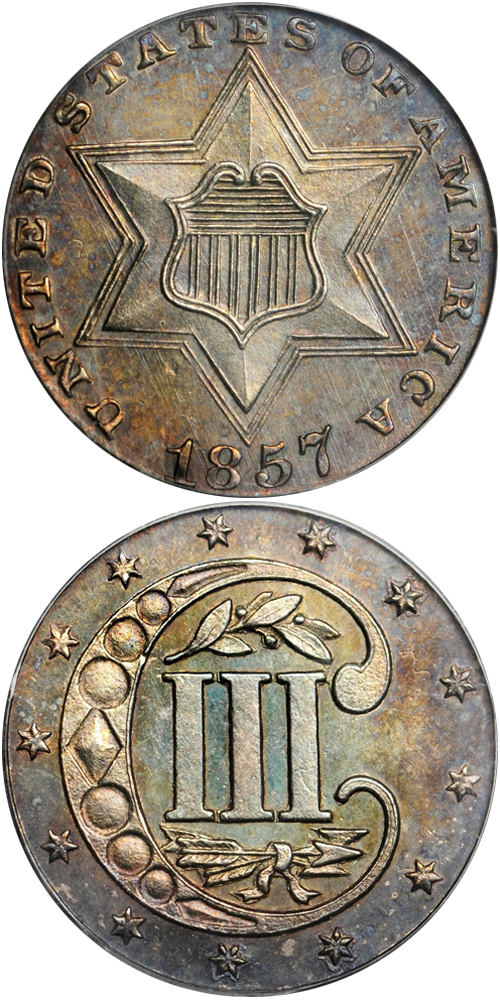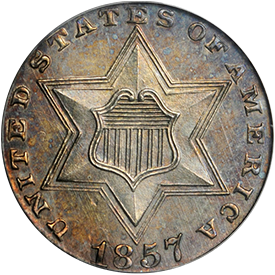Designed by: James Barton Longacre
Issue Dates: 1854-1858
Composition: 90% silver, 10% copper
Diameter: 14 mm
Weight: 0.75 grams (11.57 grains)
Edge: Plain
Business Strike Mintage: 4,914,000
In an effort to facilitate the striking up of design details, the obverse motif of the silver three-cent piece was modified in 1854 by the addition of three outlines to the star. The result was just the opposite of that intended, and pieces of the 1854-1858 years were more difficult to produce than ever. Examples seen today nearly always are weakly struck around the borders and in certain other areas as well. Indeed, the 1854-1858 silver three-cent piece is the most poorly struck of any design type of the mid 19th century.
There will be no difficulty acquiring an example of this issue in any grade desired from Good through Extremely Fine. AU coins are scarce, and Uncirculated pieces are rare. Superb Uncirculated pieces are very rare. Sharply struck coins are seldom met with. For all practical purposes, the numismatist should be satisfied with an example which shows some lightness of impression, particularly around the borders. The year 1855 is considered to be the scarcest in the range and, curiously, of the five dates of this type, the 1855 is the single date which is occasionally, very occasionally, seen with some semblance of sharp striking.
Further Reading
In 1854 the design was modified to include three outlines around the obverse star. In addition, an olive sprig and bundle of arrows were added above and below the Roman numeral III on the reverse. The metallic composition was changed to nine parts silver and one part copper. Coins of this style were made from 1854 through 1858 inclusive.
Of all three types of the silver three-cent denomination, the 1854-1858 style is the most difficult to locate. Few Uncirculated pieces were saved at the time of issue, so pieces in Mint State are quite rare today. At the tail end of the series, 1858, Proofs were just beginning to be distributed to collectors. In that year 210 Proof sets were made, each with a coin of this denomination. Proofs were made from 1854 through 1857 as well, but fewer than two dozen are known of each of these dates. Thus, a type set or date set collector desiring a top-grade piece cannot readily obtain Proofs, nor are Uncirculated coins easy to find.
Business strike examples of the 1854-1858 design are usually found weakly struck, often with parts of the lettering flat around the borders and with indistinct centers. This is quite normal for the style. Of the five dates in this range, 1854 and 1855 are occasionally seen as better strikes, but even these usually are not extremely sharp. 1856, 1857, and 1858 are nearly always extremely weak. A numismatist seeking sharply struck pieces is apt to have a lot of empty spaces in his collection!
This brings up another point: When seeking coins for your collection it is important to have reasonable expectations and to know what the possibilities of obtaining coins in certain grades and certain degrees of striking. Perhaps after reading this, you will know, for example, that an auction listing such as "1857 silver three-cent piece, sharply struck, extremely rare" would indeed represent a piece of great rarity, whereas a listing of "1861 silver three-cent piece, sharply struck, extremely rare" would indicate that the cataloguer was not very familiar with the series!
In worn grades, the availability of silver three-cent pieces of the different dates from 1854 through 1858 is approximately proportional to the mintage figures. Thus, 1855 pieces, with a mintage of 139,000, are about ten times rarer than those of 1856, which have a posted figure of 1,458,000. Of course, most silver three-cent pieces of all years have long since disappeared, but those that do survive exist in proportion to the numbers originally made.
Curiously, in Uncirculated grade the situation is different. It is my experience that the great rarity among 1854 to 1858 silver three-cent pieces in Mint State is the 1856. This observation did not come about until pictures were being selected for this book. In reviewing the historical files, I was able to find numerous auction catalogue and price list photographs of Uncirculated 1854, 1855, 1857, and 1858 coins, but just a solitary 1856! To be candid, I had completely overlooked the rarity of the 1856, believing it to be relatively plentiful-based upon the generous original mintage. However, obviously this is far from the truth. Here is a sleeper. In terms of rarity a Choice Uncirculated 1856 apparently is several times rarer than the 1855 (the date which is normally considered to be the most elusive).







